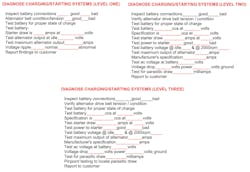Content brought to you by Motor Age. To subscribe click here.
What you will learn:
•The importance of charging for diagnostics
•How to charge for diagnostics so your customer will understand
•Why the diagnostic fee should always be separate from the repair fee within a quote
As an industry, it seems we’ve been challenged with how to charge for diagnostics as long as we’ve been diagnosing vehicles. My goal in this article is to share some different perspectives of what I see happening in the workplace that could help you better wrap your arms around this touchy subject.
When it comes to diagnosing a vehicle, I see three common practices that simply must go away.
Charging a flat fee for diagnosing a concern.
What I mean by this is when a vehicle owner calls about diagnosing a concern, they’re quoted a flat fee for the act of diagnosing and assured you’ll determine the cause of their concern. My issue with this strategy is not every diagnostic situation is created equal. You might have one vehicle that takes 15 minutes to pinpoint the cause of a throttle position sensor code to a broken resistor within the sensor and another vehicle takes four hours to find a wire in the harness chewed through because some critter developed an affinity for the soy-based wiring insulation. Quoting a flat fee for the diagnosis with the promise of a recommendation can kill profits faster than losing a toupee in a hurricane.
Hiding the diagnostic charges in with the repair labor.
This is the second most common issue I see out there as a standard practice. This makes the conversation with the car owner a lot easier but has two significant pitfalls. The first is what do you do if the car owner declines the recommend repairs, you’re presenting? If you attempt to charge them any kind of fee, then it’s going to feel like a bait and switch tactic which I know you want to avoid. The second pitfall is if the car owner decides to shop around to compare your estimate, you’re always going to be significantly higher because of the diagnostics added into the repair labor. The other shops they call will quote for the component replacement only. Try explaining your way out of that one!
"Quoting a flat fee for the diagnosis with the promise of a recommendation can kill profits faster than losing a toupee in a hurricane."
Not charging for diagnostics at all.
Thankfully, this practice is getting less and less common but it’s still out there ready to rear its ugly head when you least expect it. Let’s think this through a bit more. Which type of work in your shop typically requires the skillset of your best technician? Diagnostics. Which type of work in your shop typically requires the most expensive equipment? Diagnostics. Which type of work is the least profitable because of the lack of parts income? Yup! Diagnostics again. And lastly, out of all the work you perform, which has the highest probability of a comeback? That’s right, diagnostics! So, why do you want to give this stuff away?
Before we go any further, I’d like to recommend a word change. Instead of saying diagnostics, I recommend using the word testing for two reasons. First, some aftermarket automotive parts retailers have killed the effectiveness of diagnostic because of their “free diagnostics” offer. Now you and I both know that they’re not diagnosing the concern. They’re reading the code, plugging the code into their computer along with the pertinent vehicle information and coming up with a list of parts that could cause the issue that they start selling to the vehicle owner. The second reason I recommend changing your verbiage is because a diagnostic, when you think about it, is an outcome. I think we should take a cue from the medical profession and sell testing. You’re not selling the answer, you’re selling the process of testing which can lead to the answer.
Next, a question I get asked all the time is, “Rick, when should I charge, and when shouldn’t I charge for diagnostics?” I have a simple answer for this. It’s the difference between observing and testing. If I’m raising a vehicle on the lift and notice the engine and undercarriage is completely dry and the oil pressure switch is leaking oil, then I’ll let the owner of the vehicle know the switch is leaking because it was an observation. If, however, the engine is soaked with oil, then I’m going to recommend a dye test to determine the cause or causes of the leak and I’ll charge for that testing appropriately.
When it comes to dealing with your client as it pertains to testing their vehicle needs, I strongly suggest you have a strategy for profit before you ever touch a vehicle. You could have a higher labor rate for testing that covers the missing part sales profit. You could also use a 2:1 testing strategy meaning you control the amount of time your technician works on the vehicle while still charging an standard rate thus capturing a higher gross profit. The key here is to have a plan to profit for any testing you do before you ever do it.
I learned a long time ago that you only talk about dollars to clients and time to technicians. That’s why I recommend presenting testing to your clients in three levels. Level 1 testing covers the basic tests you’d run. Level 2 testing digs deeper into pinpoint testing and Level 3 testing is for when it’s time to roll up the sleeves and jump all in to determine their issue. Please see the example below.
The important thing when talking to the vehicle owner about testing is that your conversation includes all potential charges upfront. This conversation is going to be transparent like an open book. Make sure to emphasize the words in bold in the example here: “So, Mr. Smith, as a recap to our phone calI, we’re going to get started on the check engine light you mentioned and ask you to authorize us up to $_________ for our level one testing. Ninety percent of the time, we’re able to pinpoint the cause or causes of your concern within our Level 1 testing. Ten percent of the time, we need to escalate to level two testing. Either way, we’re going to keep you in control of the repair process by calling you and letting you know what we’ve found and where we would like to proceed next.”
If the vehicle owner pushes back on the testing fees, that’s awesome! Why? Because you haven’t invested any time or expertise into the vehicle yet. As much as it would stink if they walked away now, you haven’t lost any time or money. And it’s your opportunity to show the vehicle owner that you understand their issue, that you care, and that your shop has the skillset and technology to solve their concern. That’s the beauty of transparency, because it really is a differentiator in today’s business environment.
The last perspective I want to share with you I can demonstrate with a call I had with an advisor recently. We were reviewing their invoices and I came across one with 15 minutes of testing charged to a client. I questioned them about the charge, and they told me that the tech diagnosed the issue in 15 minutes. “No!”, I exclaimed. “It didn’t take the tech 15 minutes to diagnose the concern; it took them 30 years to diagnose it in 15 minutes!”
Let that story sink in a bit and please realize that, as an industry, we should be selling our experience not time when it comes to working on today’s complex vehicles. Each and every one of you has a unique skillset that is so much more valuable than you realize. Sell that.
If you would like access to a webinar that I presented titled, “Selling Testing Profitably," click here. Once you enter your name and email address, you’ll be able to watch this webinar that will give you even more information on this subject.
About the Author
Rick White
Rick White is a business-turnaround and exponential growth expert who helps auto repair shop owners go from struggling to stay open to being recognized as the go-to shops in their market. He helps business owners with average shops transform their shop into the shop of the year in the industry.
Currently, Rick is President of 180BIZ, an auto repair shop training and business coaching company proudly serving the independent auto and truck repair shop owner since 2006. He has also owned multiple successful auto repair shops over the years.
Rick has taught at some of the biggest conferences in the industry across North America, including classes at AAPEX (Nevada), VISION (Kansas), ASTE (North Carolina), ATSE (New York), ASA National, and AASP National. Beyond Associations, he has conducted training classes for WorldPac and BG. He has been published many times over the years for multiple automotive repair industry publications. Contact him at [email protected] or visit his website at www.180biz.com.


